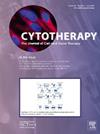DEMONSTRATING NEW APPROACHES TO SMALL-BATCH CELL THERAPY MANUFACTURE THROUGH A LABEL-FREE MICROFLUIDIC CELL SORTER
IF 3.7
3区 医学
Q2 BIOTECHNOLOGY & APPLIED MICROBIOLOGY
引用次数: 0
Abstract
Background & Aim
Automation of bioprocessing and analysis needs to be at the heart of advances in cell and gene manufacture for the transition to personalised therapies. Small-batch processes still require significant manual control and are limited to off-line quality analysis. Automated and decentralised production technologies, combined with in-line or at-line process analytical technologies, must be the route forward to realise the potential of personalised therapies. Integrating AI and machine learning (ML) into these approaches offers opportunities to reduce costs and access novel capabilities that have not yet been fully explored. Here, we demonstrate that simple and inexpensive devices can be constructed for specific applications, drawing on examples from the development of a microfluidic cell sorter. Driven by an ML algorithm, the device was designed to provide greater freedom to therapy developers without commitment to bulk manufacturing processes.
Methodology
The device was built from commercially available components. Fluid is driven by a syringe pump and controlled by a pair of rocker valves. The solution of mixed cells is held in a syringe. The mixed cells pass through a y-channel where they are imaged by an optics system. A ML algorithm identifies the cells and directs the valves to sort them into the correct channel. The total cost of all components is less than $3000.
Results
Morphologically dissimilar cells can be identified by optical imaging and separated without relying on extrinsic labelling. Cells do not require pre or post processing to add or remove fluorescent or magnetic labels. Labelling cells prior to sorting adds time and complexity to the process step and labelling physiologically similar cells for purification can be a barrier to the development of autologous cell therapies, where there is a risk of expanding and reintroducing diseased cells. The algorithm is trained to distinguish differences in the size and shape of cells. Once correctly trained, the device is applicable to any morphologically dissimilar mixture of cells delivered into the channel.
Conclusion
Increasing automation while reducing process complexity is essential for the development of personalised therapies, particularly autologous cell therapies. Automating small-batch production need not require high investment in manufacturing facilities, while leveraging new technologies and alternative approaches to manufacture can lower production times and costs, providing better outcomes for patients and developers.
通过无标记微流体细胞分选器展示小批量细胞治疗制造的新方法
背景,生物处理和分析的自动化需要成为细胞和基因制造向个性化治疗过渡的核心。小批量过程仍然需要大量的人工控制,并且仅限于离线质量分析。自动化和分散式生产技术,结合在线或在线过程分析技术,必须成为实现个性化治疗潜力的前进道路。将人工智能和机器学习(ML)集成到这些方法中,为降低成本和获取尚未充分探索的新功能提供了机会。在这里,我们证明了简单和廉价的设备可以构建特定的应用,从微流体细胞分选器的发展的例子。该设备由ML算法驱动,旨在为治疗开发人员提供更大的自由,而无需承诺批量生产流程。方法:该装置由市售元件制成。流体由注射泵驱动,由一对摇臂阀控制。混合细胞的溶液装在注射器里。混合的细胞通过一个y通道,在那里它们被光学系统成像。机器学习算法识别细胞,并指导阀门将它们分类到正确的通道中。所有部件的总成本不到3000美元。结果形态学上不同的细胞可以通过光学成像进行鉴别和分离,而不依赖于外部标记。细胞不需要预处理或后处理来添加或删除荧光或磁性标签。在分选前对细胞进行标记会增加分选过程的时间和复杂性,对生理上相似的细胞进行标记以进行纯化可能是自体细胞疗法发展的障碍,因为存在扩增和重新引入病变细胞的风险。该算法经过训练,可以区分细胞大小和形状的差异。一旦正确训练,该装置适用于任何形态不同的细胞混合物输送到通道。结论在降低过程复杂性的同时提高自动化程度对个性化治疗的发展至关重要,尤其是自体细胞治疗。自动化小批量生产不需要对制造设施进行高额投资,同时利用新技术和替代制造方法可以缩短生产时间和成本,为患者和开发人员提供更好的结果。
本文章由计算机程序翻译,如有差异,请以英文原文为准。
求助全文
约1分钟内获得全文
求助全文
来源期刊

Cytotherapy
医学-生物工程与应用微生物
CiteScore
6.30
自引率
4.40%
发文量
683
审稿时长
49 days
期刊介绍:
The journal brings readers the latest developments in the fast moving field of cellular therapy in man. This includes cell therapy for cancer, immune disorders, inherited diseases, tissue repair and regenerative medicine. The journal covers the science, translational development and treatment with variety of cell types including hematopoietic stem cells, immune cells (dendritic cells, NK, cells, T cells, antigen presenting cells) mesenchymal stromal cells, adipose cells, nerve, muscle, vascular and endothelial cells, and induced pluripotential stem cells. We also welcome manuscripts on subcellular derivatives such as exosomes. A specific focus is on translational research that brings cell therapy to the clinic. Cytotherapy publishes original papers, reviews, position papers editorials, commentaries and letters to the editor. We welcome "Protocols in Cytotherapy" bringing standard operating procedure for production specific cell types for clinical use within the reach of the readership.
 求助内容:
求助内容: 应助结果提醒方式:
应助结果提醒方式:


